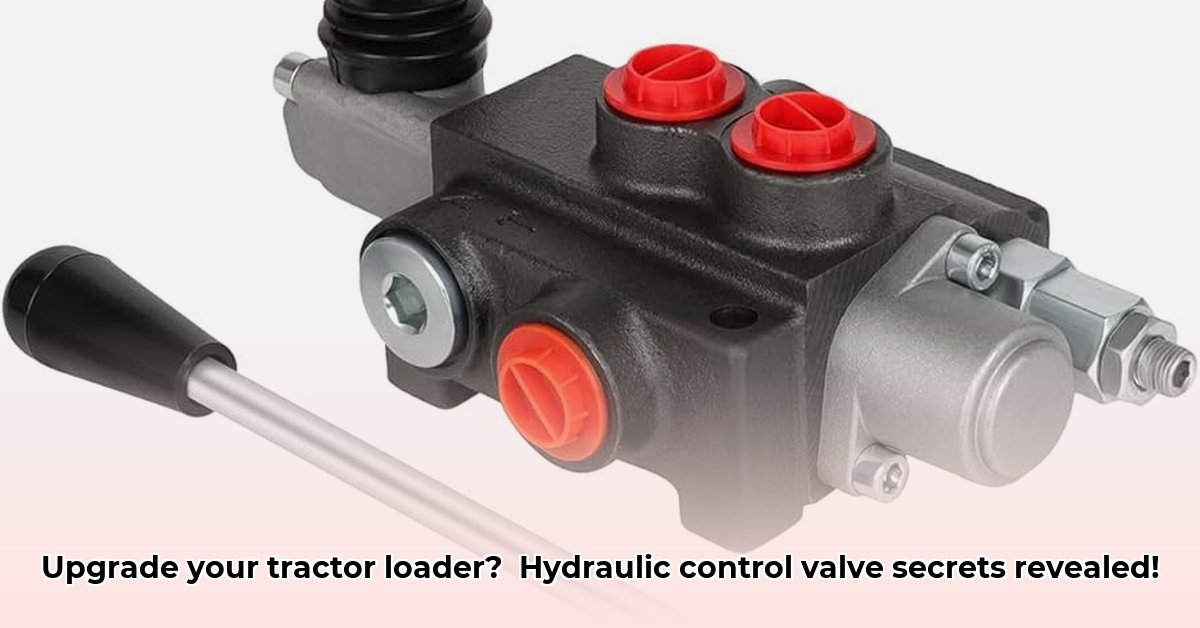
Hydraulic Control Valve Selection and Installation: A Practical Guide
Upgrading your tractor loader's hydraulic system can significantly boost efficiency and performance. A key component in this upgrade is the hydraulic control valve. This guide provides a practical overview of selecting, installing, and maintaining the Summit Hydraulics directional control valve, a popular choice for enhancing tractor loader capabilities. We'll cover compatibility, troubleshooting, and best practices to ensure optimal results. For more powerful hydraulics, check out this tractor snow plow.
Decoding Your Tractor's Hydraulic System: Open vs. Closed Center
Before selecting a valve, understanding your tractor's hydraulic system is crucial. There are two main types: open-center and closed-center systems. An open-center system constantly circulates hydraulic fluid, even when the implements aren't operating. A closed-center system only moves fluid when actively controlled, resulting in greater efficiency. Knowing your system type is essential for valve compatibility. Incorrect selection can lead to poor performance or even damage.
The Summit Hydraulics Valve: Specifications and Features
The Summit Hydraulics directional control valve boasts robust specifications, making it a suitable choice for demanding applications:
| Specification | Metric | Imperial | Notes |
|---|---|---|---|
| Maximum Operating Pressure | 250 bar | 3625 PSI | Do not exceed this pressure. |
| Maximum Flow Rate | 79.5 l/min | 21 GPM | Adjust based on your tractor's pump capacity. |
| Spool Types | 'A' (Double-Acting), 'D' (Motor) | 'A' (Double-Acting), 'D' (Motor) | 'A' for double-acting cylinders, 'D' for motors. |
| Mounting Options | Vertical, Horizontal | Vertical, Horizontal | Choose based on available space and system layout. |
This high flow rate and pressure capacity translates to quicker response times and more powerful lifting capabilities. The spool type selection depends on whether your loader uses hydraulic cylinders ("A" spool) or motors ("D" spool).
Did you know? A higher flow rate generally means faster implement movement, while higher pressure allows for heavier loads to be lifted. What are your loader's typical tasks and weight requirements?
System Compatibility: Ensuring Seamless Integration
Choosing a valve compatible with your tractor's hydraulic system is absolutely vital. Does your tractor feature "Power Beyond" functionality? This allows connecting additional hydraulic components beyond the standard loader. Consult your tractor's manual to confirm compatibility and any special requirements. Detailed diagrams in the manual will help ensure proper connections.
Installation: A Step-by-Step Approach (Professional Installation Recommended)
While some users might attempt installation themselves, it's strongly recommended to engage a qualified professional. Hydraulic systems are complex and require specialized knowledge. Installation is not covered here for safety reasons, and improper installation might cause severe damage.
Operation and Maintenance: Key Practices for Extended Lifespan
Proper operation and regular maintenance are essential for maximizing efficiency and preventing damage. Always follow specified operating procedures.
- Regular Inspection: Check for leaks at all connections and around seals regularly. Address any seepage.
- Fluid Changes: Follow the manufacturer’s recommendations for hydraulic fluid changes. Contaminated fluid can degrade performance.
- O-Ring Inspection: Periodically inspect all O-rings for wear and tear. Replace any damaged components.
Important Note: Neglecting maintenance significantly reduces valve lifespan and increases chances of costly repairs. "Preventative maintenance is always cheaper than fixing a broken system," says Dr. Anya Sharma, Mechanical Engineering Professor at Purdue University.
Troubleshooting Common Issues
Here are solutions for common problems encountered with hydraulic control valves:
- Leaks: Leaks typically indicate loose connections or worn seals. Tighten connections carefully and replace damaged seals/O-rings.
- Malfunctions: If the valve doesn't operate as expected, check for blockages in hydraulic lines. Consult the manufacturer's troubleshooting guide for more complex issues.
Conclusion: Maximizing Your Tractor Loader's Potential
Choosing the correct hydraulic control valve is essential for optimizing your tractor loader's performance and efficiency. Careful consideration of your tractor's hydraulic system, the valve's specifications, and proper installation will greatly enhance your loader's productivity and lifespan. Remember to prioritize safety and consult professionals when necessary.